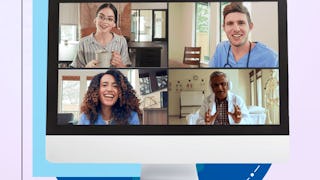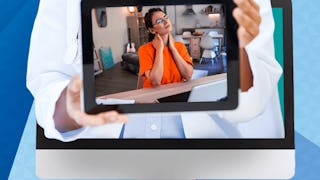Telehealth uses technology tools such as a cellphone or laptop to give patients and doctors the ability to support healthcare communication and services remotely. The field of telehealth has seen tremendous growth, with telehealth use increasing across all specialties and becoming even more accessible.

5 days left: Get a Black Friday boost with $160 off 10,000+ programs. Save now.


(12 reviews)
Recommended experience
What you'll learn
Examine the real-world application of telehealth from a world-class, research university medical center with over 30-years of practice.
Skills you'll gain
Details to know

Add to your LinkedIn profile
4 assignments
See how employees at top companies are mastering in-demand skills

There are 4 modules in this course
In this module, you will be able to understand the role of telehealth in the healthcare continuum and recognize the three types of telehealth. You will be able to explain the different roles and relationships of the participants in different encounter types. You will be able understand the benefits to the participants in the different encounter types and explain how telehealth can address the six domains of healthcare quality. You will be able to identify who can benefit from telehealth using different perspectives and review common applications of telehealth. You will also be able to explore the return on investment in specific settings.
What's included
8 videos1 reading1 assignment2 discussion prompts
In this module, you'll be able to define health equity and discuss the components of it. You will also be able to define health disparities and discuss the impact of health inequity on health disparities. You will be able to understand the ways in which telehealth is designed to promote health equity and recognize the ways in which it has also promote health equity. You will be able to understand the importance of monitoring the impacts that telehealth technology has on relevant outcomes and understand that although these technologies have potential to promote health equity, we must recognize the ways in which telehealth does not equitably benefit diverse populations. Finally, you will be able to recognize that telehealth equity issues are an understudied area and, as a result, we must be aware of the possible unintended consequences of these tools so that these innovative technologies improve, rather than exacerbate, existing disparities.
What's included
6 videos1 assignment1 discussion prompt
In this module, you will be able to recognize the role of Institutional Culture plays in telemedicine and be able to explore the cultural framework for your organization and establish expectations. You will be able to recognize different telehealth modalities and understand the dynamics of a telehealth visit. You will be able to recognize and apply best practices for a provider during a telehealth visit and be able to standardize the approach to both the physical and virtual office space. You will be able to implement Clinical Practice Guidelines and recognize the steps in the coordination of care. You will be able to prepare for support, explore both the SPIKES and NURSE protocols, and be able to communicate bad news empathetically and effectively.
What's included
8 videos1 assignment1 discussion prompt
In this module, you will be able to recognize the effect of organizational design on a telehealth program. You will be able to determine drivers for program utilization and be able to monitor program using Continuous Quality Improvement (CQI) methods. You will also be able to identify elements of appropriate program management and plan for technical needs of users. You will be able to compare and contrast licensure and credentialing and follow state licensure compacts. You will be able to recognize the different state and federal policies for reimbursement, prescribing, privacy and security as well as be able to explore other laws and regulations that impact telehealth.
What's included
8 videos1 assignment2 discussion prompts
Instructor

Offered by
Explore more from Public Health
 Status: Free Trial
Status: Free TrialDuke University
 Status: Preview
Status: PreviewJohns Hopkins University
 Status: Free Trial
Status: Free TrialDuke University
 Status: Free Trial
Status: Free TrialDuke University
Why people choose Coursera for their career





Open new doors with Coursera Plus
Unlimited access to 10,000+ world-class courses, hands-on projects, and job-ready certificate programs - all included in your subscription
Advance your career with an online degree
Earn a degree from world-class universities - 100% online
Join over 3,400 global companies that choose Coursera for Business
Upskill your employees to excel in the digital economy
Frequently asked questions
To access the course materials, assignments and to earn a Certificate, you will need to purchase the Certificate experience when you enroll in a course. You can try a Free Trial instead, or apply for Financial Aid. The course may offer 'Full Course, No Certificate' instead. This option lets you see all course materials, submit required assessments, and get a final grade. This also means that you will not be able to purchase a Certificate experience.
When you purchase a Certificate you get access to all course materials, including graded assignments. Upon completing the course, your electronic Certificate will be added to your Accomplishments page - from there, you can print your Certificate or add it to your LinkedIn profile.
Yes. In select learning programs, you can apply for financial aid or a scholarship if you can’t afford the enrollment fee. If fin aid or scholarship is available for your learning program selection, you’ll find a link to apply on the description page.
More questions
Financial aid available,

